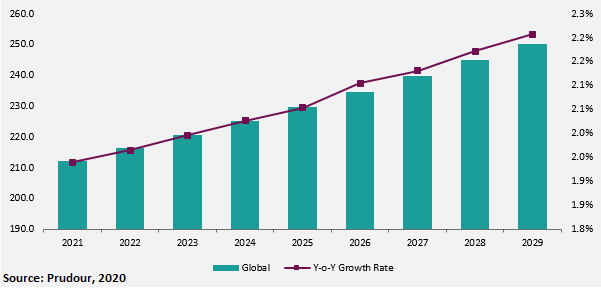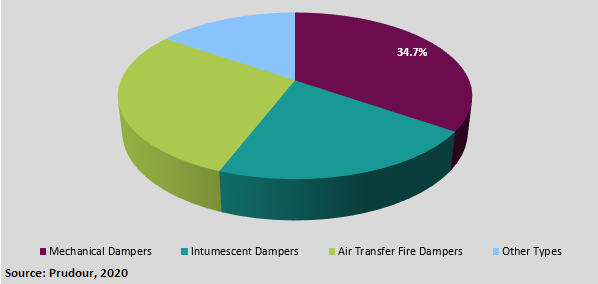Global Fire Damper Market By Type (Mechanical Dampers, Intumescent Dampers, Air Transfer Fire Dampers, and Types), By Application (Residential Buildings, Commercial Buildings, Industrial Buildings, Marine, and Applications), By Region and Key Companies - Industry Segment Outlook, Market Assessment, Competition Scenario, Trends and Forecast 2029
- Published date: May 2023
- Report ID: 18663
- Number of Pages: 278
- Format:
- keyboard_arrow_up
“Global Fire Dampers Market” is the title of an upcoming report offered by Market.US. This report on the fire dampers industry contains information and data, and inputs from both primary and secondary data sources, that have been verified and validated by experts in the target market. It also covers threats or challenges for existing as well as new entrants in the market. The report presents a thorough study of revenues, historical data, and information, key developments, and strategies by major players that offer vital insights and perspectives in to various scenarios market. Besides critical data and related information, the report includes key trends (both present and future), factors that are driving market growth, factors that are or could be potential restraints to market growth, as well as opportunities that can be leveraged for potential revenue generation in untapped regions and countries. The global fire dampers market has been segmented on the basis of product type, application, as well as regions and countries.
The Global Fire Dampers Market was valued at UЅD $208.2 Мn in 2020, and is projected to register а САGR of 2.2% over the next 10 years.

Overview:
Fire dampers are passive fire protection products used in ventilation, heating, and air-conditioning ducts to prevent the spread of fire inside the ductwork through fire-resistance rated walls and floors.
Dynamics:
As fire dampers are the first line of defense against any outbreaks, accidental or otherwise, and fire safety being a primary area of focus for numerous industries, an exponential demand in fire protection products is anticipated over the next 10 years owing to the robust expansion of these end-use industries. This is a primary factor that is slated to have a profound impact on the revenue growth of the global fire dampers market.
Substantial growth in urban populations is leading to the further development of residential and commercial infrastructures. This boost in construction activity, and the requirement for structures to adhere to strict health & safety regulations set by governing bodies, is another factor that is anticipated to have a significant influence on the revenue growth of the global fire dampers market over the forecast period.
In light of the recent COVID-19 outbreak, the operations of key industry players in the fire damper market have either been temporarily halted, or are functioning with a minimal workforce. This is expected to have a negative impact on this global industry. Moreover, strict enforcement of guidelines concerning the use of adequate and appropriate fire safety procedures and equipment is also slated to negatively impact this global industry.
However, the increasing adoption of efficient Heating, Ventilation, and Air-conditioning (HVAC) systems that implement the latest in innovative product advancements is a factor that is expected to further compliment future revenue growth of the global fire dampers market.
Segmentation of the global fire dampers market is as follows:

On the basis of product type, the mechanical dampers segment accounted for the maximum number of revenue shares (34.7%) of the global fire dampers market in 2020, and is anticipated to index the highest CAGR over the forecast period. The intumescent dampers segment also accounted for a considerable number of revenue shares of this global market in 2020, and is slated to continue to do so over the next 10 years.

In terms of application, the commercial buildings segment accounted for the majority revenue shares of the global fire dampers market in 2020, and is projected to register the highest CAGR, with an attractiveness index of 5.3, over the forecast period. The residential buildings segment accounted for the second-highest number of revenue shares of the global fire dampers market in 2020, and is expected to continue to do so for the years to come.
Regional Segmentation and Analysis:

North America accounted for the majority number of revenue shares (38.4%) of the global fire dampers market in 2020, and is anticipated to remain this market’s front-runner for the remainder of the forecast period. The markets in Europe accounted for the second-highest number of revenue shares in 2020, and is indicative of continuing to do so over the next decade.
Segmentation of the Global Fire Dampers Market:
Segmentation by Product Type:
- Mechanical Dampers
- Intumescent Dampers
- Air Transfer Fire Dampers
- Other Types
Segmentation by Application:
- Residential Buildings
- Commercial Buildings
- Industrial Buildings
- Marine
- Other Applications
Segmentation by Region:
- North America
- Europe
- Asia Pacific
- Latin America
- Middle East & Africa
Key players profiled in the market report are:
- TROX GmbH
- FläktGroup Holding GmbH
- Swegon Air Management Limited
- RF Technologies Inc.
- Flamgard Calidair
- Aldes International
- Systemair AB
- Ventilation Systems JSC
- Lloyd Industries
- Ruskin Co.
- Greenheck
- The Halton Group
- Nailor Industries Inc.
- MP3 Srl
- Lorient Polyproducts Ltd.
For the Fire Damper Market research study, the following years have been considered to estimate the market size:
Attribute Report Details Historical Years
2016-2020
Base Year
2021
Estimated Year
2022
Short Term Projection Year
2028
Projected Year
2023
Long Term Projection Year
2032
Report Coverage
Competitive Landscape, Revenue analysis, Company Share Analysis, Manufacturers Analysis, Volume by Manufacturers, Key Segments, Key company analysis, Market Trends, Distribution Channel, Market Dynamics, COVID-19 Impact Analysis, strategy for existing players to grab maximum market share, and more.
Regional Scope
North America, Europe, Asia-Pacific, South America, Middle East & Africa
Country Scope
United States, Canada and Mexico, Germany, France, UK, Russia and Italy, China, Japan, Korea, India and Southeast Asia, Brazil, Argentina, Colombia etc.Saudi Arabia, UAE, Egypt, Nigeria and South Africa

- TROX GmbH
- FläktGroup Holding GmbH
- Swegon Air Management Limited
- RF Technologies Inc.
- Flamgard Calidair
- Aldes International
- Systemair AB
- Ventilation Systems JSC
- Lloyd Industries
- Ruskin Co.
- Greenheck
- The Halton Group
- Nailor Industries Inc.
- MP3 Srl
- Lorient Polyproducts Ltd.
- settingsSettings
Our Clients
| Single User $4,599 $3,499 USD / per unit save 24% | Multi User $5,999 $4,299 USD / per unit save 28% | Corporate User $7,299 $4,999 USD / per unit save 32% | |
|---|---|---|---|
| e-Access | |||
| Report Library Access | |||
| Data Set (Excel) | |||
| Company Profile Library Access | |||
| Interactive Dashboard | |||
| Free Custumization | No | up to 10 hrs work | up to 30 hrs work |
| Accessibility | 1 User | 2-5 User | Unlimited |
| Analyst Support | up to 20 hrs | up to 40 hrs | up to 50 hrs |
| Benefit | Up to 20% off on next purchase | Up to 25% off on next purchase | Up to 30% off on next purchase |
| Buy Now ($ 3,499) | Buy Now ($ 4,299) | Buy Now ($ 4,999) |












